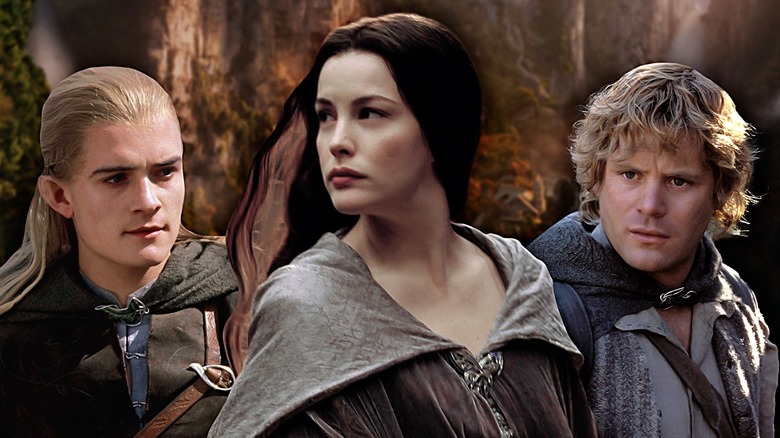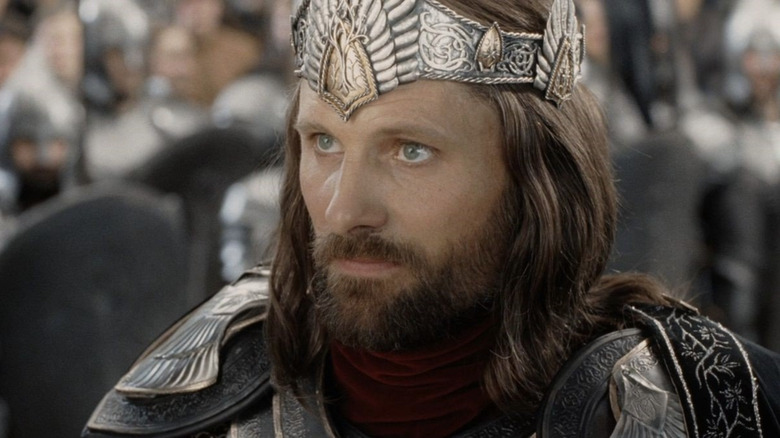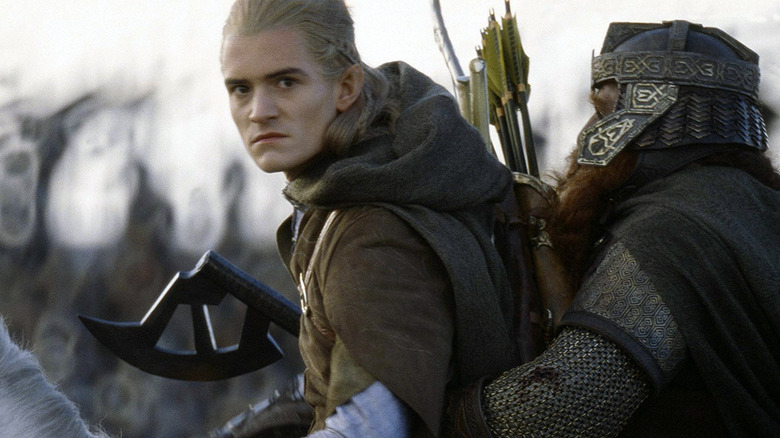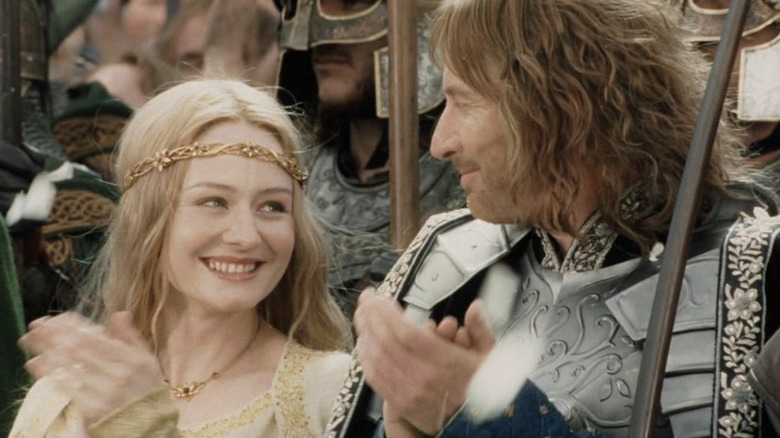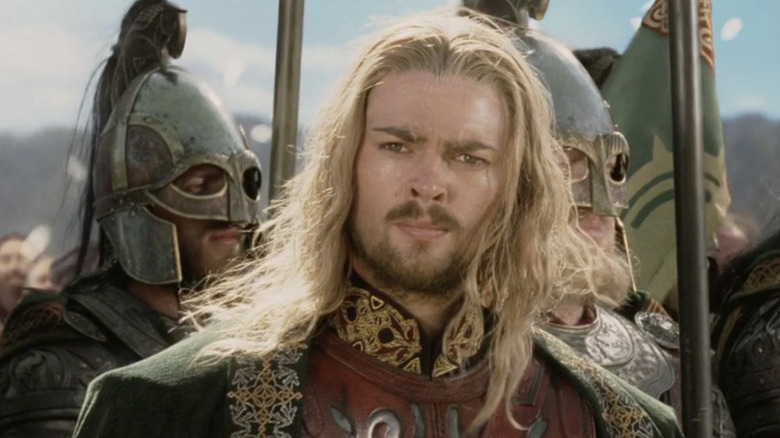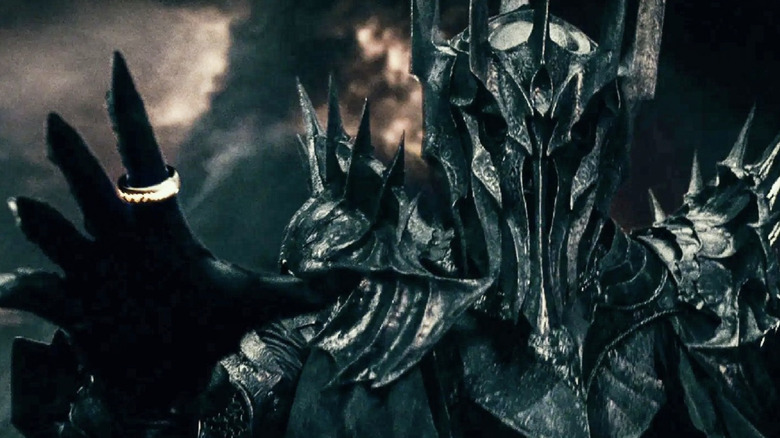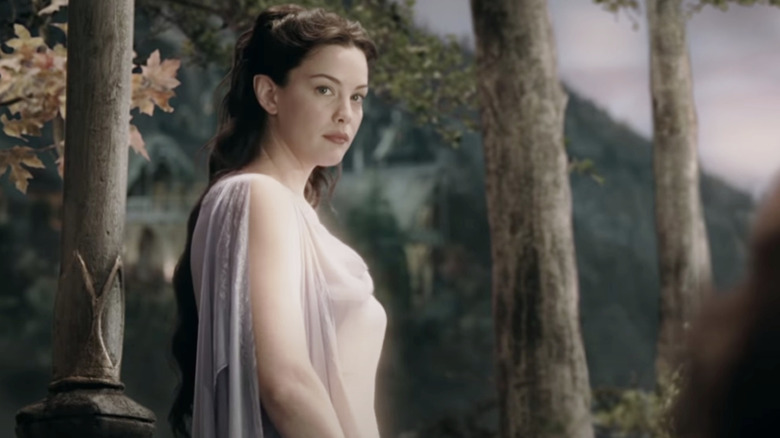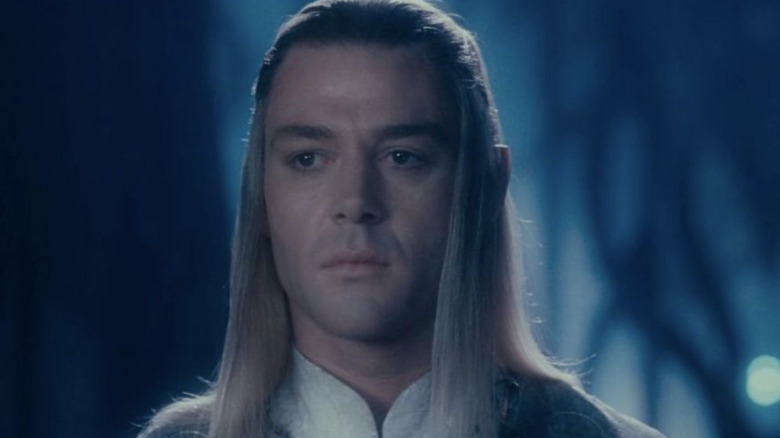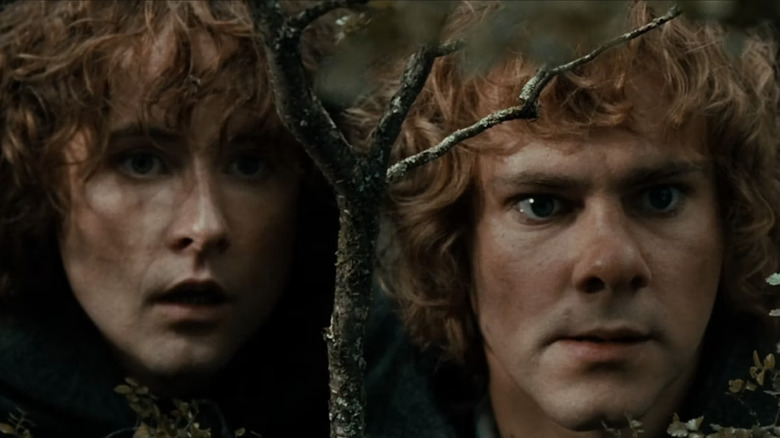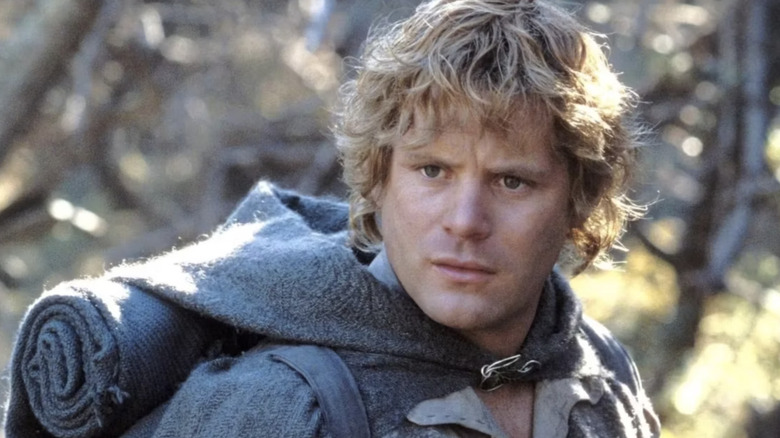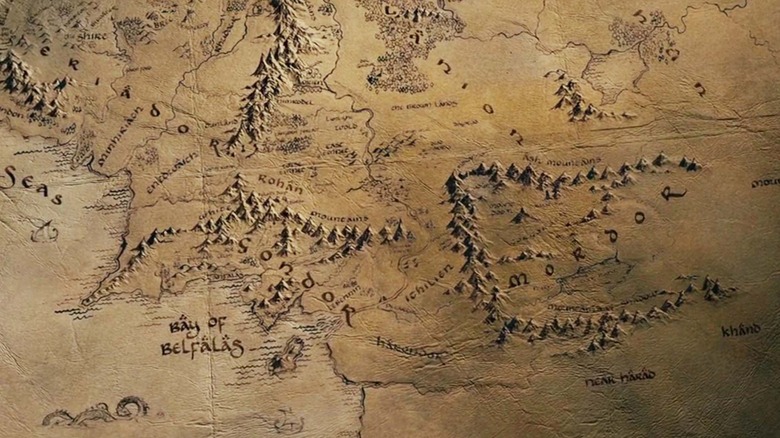Whatever Happened To These Characters After The Lord Of The Rings?
There's no denying that Peter Jackson's "The Lord of the Rings" trilogy is one of the greatest feats in modern filmmaking. The adaptation of J.R.R. Tolkien's high-fantasy epic has garnered plenty of praise over the years, despite some of the big differences from the original novels. Concluding with "The Lord of the Rings: The Return of the King," the trilogy-closer is also well-known for having a particularly long-winded ending. Still, even that last hour couldn't fully elaborate on what happened to some of our favorite characters, many of whom we never see again after Aragorn's (Viggo Mortensen) coronation.
When we last see Frodo (Elijah Wood), he, Gandalf (Ian McKellen), Bilbo (Ian Holm), and many of the Elves sail off to the Undying Lands. Because of Frodo and Bilbo's status as ring-bearers, they were granted the eternal peace that is often only reserved for the Elves. And that's how the trilogy ends, with them sailing off into the unknown, leaving their friends behind in Middle-earth. But that's not exactly the end of the story. While Jackson's trilogy may not expand much more on what becomes of the other characters, Tolkien's original works had a lot more to say about our heroes and even some villains.
If you always wondered what happened to the rest of the Fellowship, their allies, and even the Dark Lord, Sauron himself, then we've got some answers for you. With Middle-earth saved, this is what happened to everybody else.
Aragorn went on to become King
At the end of "Return of the King," Aragorn fulfills his birthright and is finally crowned King of Gondor. He marries his true love, Arwen (Liv Tyler), and refuses to let his Hobbit friends bow to him after their courage. Given the title King Elessar Telcontar by Galadriel (Cate Blanchett), Aragorn brought a new sort of peace to Gondor and Arnor in his many years as King. He ended up living to be 210 years old and officially ushered in the Fourth Age of Middle-earth. He was the 26th King of Arnor, the 35th King of Gondor, and the first High King of the Reunited Kingdom.
Ruling over the House of Telcontar — which is a form of Elvish for "Strider," the name he adopted when ran with the Dúnedain Rangers — it was Aragorn who initiated a longstanding peace between Men, Elves, and Dwarves following the War of the Ring. Additionally, he led a campaign to reclaim much of the land that Gondor and Arnor had lost during the time there wasn't a king on the throne. This largely centered around conquering the Easterlings and Haradrim, who had previously fought for Sauron during the Third Age.
When he reached his final year, Aragorn recognized that his life was at an end and passed his crown onto his son Eldarion, who ruled faithfully in his stead. Retiring to the House of Kings, Aragorn died with Arwen by his side.
Legolas and Gimli went on their own adventure
Following the War of the Ring, Legolas (Orlando Bloom) and Gimli (John Rhys Davies) took a "victory lap" tour of their own, traveling through Helm's Deep into the Glittering Caves, and eventually Fangorn Forest. Throughout "The Lord of the Rings" novels, Gimli makes a note of wanting to show Legolas the grandeur and spectacle built by his kin, and the Elf honors his wish. They spend a decent amount of time traveling together throughout Middle-earth, with no world-ending quest weighing heavy on them. Eventually, Legolas travels to Ithilien to help rebuild the forestlands that were corrupted during the War of the Ring and lives out the rest of his days in Middle-earth in peace.
Gimli on the other hand became the Lord of the Glittering Caves, and, under his command, a group of Dwarves rebuilt the Middle-earthen wonder that had also been damaged during the war. They even reconstructed the gates of Minas Tirith. According to Tolkien's appendix at the end of "The Return of the King," Gimli, who was named an Elf-friend, was granted passage to the Undying Lands alongside Legolas after Aragorn's passing. Tolkien himself admits this strange given the context of his cosmology, but remarks that the Dwarf — who is the only one to ever be granted access to the Undying Lands — wished to gaze upon the Lady Galadriel once again and that she "obtained this grace for him." Even in the end, Legolas and Gimli were inseparable.
Faramir and Éowyn remained in Gondor
Compared to the movies, "The Lord of the Rings" books expand so much more on the world of Middle-earth and the characters within it. One important detail that the films only allude to is the complex relationship between Faramir (David Wenham) and Éowyn (Miranda Otto). In the book, Éowyn is still as love-sick for Aragorn as ever — which is a lot more one-sided in the books — but moves past it on her own accord after spending some time in the Houses of Healing alongside Faramir. The two of them eventually kindle a romance and marry sometime after Théoden's funeral.
Before Aragorn is officially crowned King Elessar, Faramir briefly takes over his late father's occupation as the Steward of Gondor, surrendering his office to his new king. But, due to Faramir's bravery and character, Aragorn promoted Faramir to Prince of Ithilien, made him the Captain of his White Company, and allowed him to remain the Steward of Gondor as well. Eventually, Faramir and Éowyn settle down in Emyn Arnen, which is just south of Osgilliath, where they have their first son Elboron, who eventually succeeds his father's role as Steward. Though we don't know when exactly Éowyn died, Faramir lived to be 120 years old, proving that Númenorian blood ran through his veins after all.
Éomer becomes King of Rohan
Following the death of his uncle at the hand of the Witch-King during the Battle of Pelennor Fields, Éomer succeeded Théoden as King of Rohan, a title also called the Lord of the Mark. After Sauron fell, Éomer and his men embarked on Edoras and returned their fallen king's body to his home kingdom. The War of the Ring had forever bonded the Men of Gondor and Rohan, and as such Éomer and Aragorn swore an oath that pledged their loyalty and friendship to one another. Whenever Gondor would call for aid, Rohan would be sure to answer, and vice versa.
Eventually, Éomer was known as Éomer Éadig — which translates to "The Blessed" — due to his commitment to making Rohan a great nation and people again. Under his rule, the country prospered, and he and King Elessar could often be seen riding together in battle against any enemies that still lurked about. At some point during his reign, Éomer met and married Lothíriel, the daughter of Prince Imrahil (a character not seen in the movies but who is very notable in the books). With Lothíriel by his side, Éomer's bloodline continued to rule after his eventual passing, through their son Elfwine, a name that means "Elf-friend." To say that Éomer honored Théoden's legacy would be an understatement.
Sauron never returns to Middle-earth
This one might seem obvious, but given that the Peter Jackson films don't elaborate much on Sauron other than he's a Dark Lord with a peculiar choice of jewelry, it's worth noting what became of Sauron here. As one of the Maiar, Sauron can't be completely destroyed. Sure, the One Ring tethered him to the physical world, but his spirit remains, even after its destruction. "If [the Ring] is destroyed, then he will fall, and his fall will be so low that none can foresee his arising ever again," Tolkien wrote in "The Return of the King." And how true that was.
After the Ring was destroyed in Mount Doom and Aragorn and his forces invaded the Black Gate of Mordor, Sauron was defeated. While the Dark Lord never comes out and fights (though the books imply he has a physical body, and that he's not just a giant eye) he falls even still. Because his final source of power had evaporated, so did Sauron's physical form. The Dark Lord was stripped of his power and ushered back into the spirit realm, where he hovered above Mordor until he was blown away by a gust of wind. Because Sauron had lost all his power, he was unable to raise new forces to take back Middle-earth, and the Lord of the Rings was forever defeated.
Arwen died of a broken heart
Arwen has a vast and complicated history spanning far back to the early years of the Third Age of Middle-earth, and though her role in the Peter Jackson films is important, she isn't in the books extensively. Much of her role in the movie is filled by Glorfindel, an Elf who came back from the dead. But that aside, what we do know about Arwen that was translated into the films comes from Tolkien's appendix, specifically "The Tale of Aragorn and Arwen." In-universe, this romance was penned by Faramir's grandson Barahir following the death of King Elessar, most likely to honor his memory.
Alongside her husband, Arwen spent decades living a happy life in Gondor, having given her spot on the ships sailing for Valinor to Frodo for his heroism. After being married to Aragorn for 122 years, he died at the ripe old age of 210, which isn't too shabby for a Man, even one with Númenorian ancestors. Not long after, Arwen retreated to Cerin Amroth in Lórien where she too died of a broken heart, finally passing as a mortal at the age of 2901 years old. If that seems like a lot, it's worth remembering that her grandmother Lady Galadriel was over 8,000 by the time of "The Lord of the Rings."
Celeborn remained in Middle-earth
Speaking of Galadriel, one character who appears briefly in the Peter Jackson trilogy (and who has yet to appear on Amazon's "The Lord of the Rings: The Rings of Power") is Celeborn (Marton Csokas). "Kinsman, farewell! May your doom be other than mine, and your treasure remain with you to the end," the Elf Lord tells Aragorn in Tolkien's original novel. Though these ominous tidings seem, well, strange at first, they make more sense later in light of the Elf Lord's ultimate tragic fate. In the book, Celeborn and Galadriel don't go to the Undying Lands together as they do in the movie, and we're not exactly sure how long they live apart either.
In the book, Galadriel still leaves Middle-earth at the end of the Third Age. She's been around for a long time and she's ready to go to Valinor. But Celeborn stays behind, opting not to leave Middle-earth and his kin there just yet. Years passed, and Celeborn spent many of his remaining years on Middle-earth with his grandsons, Elladan and Elrohir (who are Elrond's sons), until he was ready to finally depart. When he did, Tolkien explained in his prologue to "The Lord of the Rings" that "with [Celeborn] went the last living memory of the Elder Days of Middle-earth." That certainly frames the final Grey Havens scene in "The Return of the King" a bit differently.
Merry and Pippin were buried in Gondor
Once again, the prologue to "The Lord of the Rings" spoils some key information about our heroes. Concerning Meriadoc "Merry" Brandybuck (Dominic Monaghan) and Peregrin "Pippin" Took (Billy Boyd), Tolkien writes that they "became the heads of their great families, and at the same time kept up their connexions with Rohan and Gondor." This isn't exactly surprising. Pippin became one of Gondor's own during "The Return of the King," and Merry fought valiantly during the Battle of Pelennor Fields. Éowyn even fought for Merry to receive honors due to his bravery, and he was knighted and later awarded the Horn of Rohan (which he used to save the Shire).
Both Merry and Pippin marry further down the road, with Pippin fathering a son that he names after Faramir (who ended up marrying Sam's daughter Goldilocks Gardner). The two remain in the Shire (after saving it from Saruman, but that part isn't in the movie) for most of their lives until Éomer calls upon Merry one last time. The two Hobbits, now up there in age, travel to Rohan where they witness Éomer's passing, only to then detour to Gondor to visit with their former friend, King Elessar, where they eventually die. It's not all sad, however, both Hobbits are buried with honors in Rath Dínen — Gondor's tombs of royalty — and end up lying alongside Aragorn eternally in death.
Samwise Gamgee went to the Undying Lands
Considered by Tolkien to be the "true hero" of "The Lord of the Rings," Samwise Gamgee certainly lived a more exciting life than he'd ever hoped to. Upon returning to the Shire in the films, Sam eventually gets the nerve to ask out Rosie Cotton (Sarah McLeod), and the two marry and live happily ever after. Though things play out a bit differently in the books — with Sam proving himself in battle during the "Scouring of the Shire" — Sam still marries Rosie at the end of the story, and the two end up with thirteen children, some of them named after Sam's friends Frodo, Merry, Pippin, and Bilbo.
But aside from being a faithful husband, father, and gardener, Sam is also Frodo's closest friend. When Frodo decides to leave Middle-earth for Valinor, he gifts Sam all of Bag End and the Red Book of Westmarch (where all these tales are written in the first place). Sam even becomes the Mayor of the Shire, and he and his family (later called the Gardners) live happily there for many years. When Rosie died 61 years into the Fourth Age, Sam passed down the Red Book to his eldest daughter Elanor, and ventured to the Gray Havens himself. Because Sam too was a Ring Bearer for a short time, he was given access to the Undying Lands, where he reunited with Frodo in a new life.
Middle-earth became a different place in the Fourth Age
Known as the "Age of Men," the Fourth Age of Middle-earth was significantly different from the rest due, in part, to the departure of the Elves and the fall of Sauron. With King Elessar ruling faithfully over the Reunited Kingdom, and Sauron's forces at Mordor vanquished, this age is somewhat boring compared to the rest. But for Middle-earth, boring is good. Peace and prosperity were the norm throughout Middle-earth during the Fourth Age, and although there were still some enemy forces out there, nothing as big as Sauron ever rose again, proving that Frodo's quest wasn't for nothing.
You may not know, but Tolkien briefly considered a sequel to "The Lord of the Rings," which he titled "The New Shadow." The tale was to take place during the reign of Aragorn's son Eldarion and revolved around a Satanic-like group named the Dark Tree. Unsurprisingly, nothing ever came of it, and he soon scrapped the idea altogether. "I did begin a story placed about 100 years after the Downfall [of Mordor], but it proved both sinister and depressing," Tolkien wrote to a fan in a letter collected in "The Letters of J.R.R. Tolkien." "I could have written a 'thriller' about the plot [surrounding the Dark Tree] and its discovery and overthrow — but it would have been just that. Not worth doing." Tolkien was right though, not pursuing a sequel to "The Lord of the Rings" was probably for the best.
